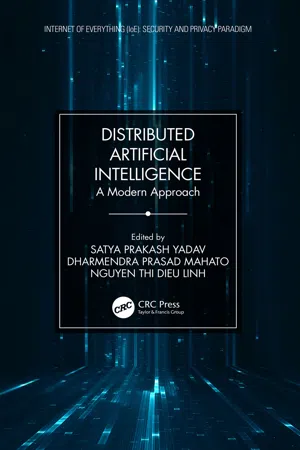
Distributed Artificial Intelligence
A Modern Approach
- 322 pages
- English
- ePUB (mobile friendly)
- Available on iOS & Android
Distributed Artificial Intelligence
A Modern Approach
About This Book
Distributed Artificial Intelligence (DAI) came to existence as an approach for solving complex learning, planning, and decision-making problems. When we talk about decision making, there may be some meta-heuristic methods where the problem solving may resemble like operation research. But exactly, it is not related completely to management research. The text examines representing and using organizational knowledge in DAI systems, dynamics of computational ecosystems, and communication-free interactions among rational agents. This publication takes a look at conflict-resolution strategies for nonhierarchical distributed agents, constraint-directed negotiation of resource allocations, and plans for multiple agents.
Topics included plan verification, generation, and execution, negotiation operators, representation, network management problem, and conflict-resolution paradigms. The manuscript elaborates on negotiating task decomposition and allocation using partial global planning and mechanisms for assessing nonlocal impact of local decisions in distributed planning.
The book will attract researchers and practitioners who are working in management and computer science, and industry persons in need of a beginner to advanced understanding of the basic and advanced concepts.
Frequently asked questions
Information
1 Distributed Artificial Intelligence
1.1 Introduction
- 1. It is a technique for the dispersion of jobs between operators;
- 2. It is a technique for dispersion of forces;
- 3. It is a technique for communicating among the participating agents.
1.2 Why Distributed Artificial Intelligence?

- Self-sufficiency: agents work without the immediate mediation of people or others, and have an authority over their activities and inside state.
- Social capacity: agents collaborate with different agents (and conceivably people) through a specialist correspondence language.
- Reactivity: agents see their condition (which might be the physical world, a client by means of a graphical UI, an assortment of different specialists, the Internet, or maybe these joined), and react in an auspicious design to changes that happen in it.
- Pro-animation: agents do not just act in light of their condition; they can show objective coordinated conduct by stepping up to the plate.

1.3 Characteristics of Distributed Artificial Intelligence
- 1. Distributed artificial intelligence (DAI), also called decentralized artificial intelligence, is a subfield of artificial intelligence (AI) that is committed to the improvement of distributed reasoning for issues.
- 2. DAI is firmly identified by multi-agent systems and distributed problem solving (DPS).
- 3. The goals of DAI are to illuminate the thinking, arranging, learning, and recognition issues of AI, particularly when they require enormous amounts of information, by passing off the issue to independent agents.
- 4. DAI takes into consideration the interconnection and interoperation of different existing hereditaments system. By building an agent sheath around such legacy systems, they can be incorporated into the agents list.
- 5. DAI upgrades framework system execution, explicitly usi...
Table of contents
- Cover
- Half-Title
- Series
- Title
- Copyright
- Contents
- Preface
- Editors
- Contributors
- Chapter 1 Distributed Artificial Intelligence
- Chapter 2 Intelligent Agents
- Chapter 3 Knowledge-Based Problem-Solving: How AI and Big Data Are Transforming Health Care
- Chapter 4 Distributed Artificial Intelligence for Document Retrieval
- Chapter 5 Distributed Consensus
- Chapter 6 DAI for Information Retrieval
- Chapter 7 Decision Procedures
- Chapter 8 Cooperation through Communication in a Distributed Problem-Solving Network
- Chapter 9 Instantiating Descriptions of Organizational Structures
- Chapter 10 Agora Architecture
- Chapter 11 Test Beds for Distributed AI Research
- Chapter 12 Real-Time Framework Competitive Distributed Dilemma
- Chapter 13 Comparative Studied Based on Attack Resilient and Efficient Protocol with Intrusion Detection System Based on Deep Neural Network for Vehicular System Security
- Chapter 14 A Secure Electronic Voting System Using Decentralized Computing
- Chapter 15 DAI for Document Retrieval
- Chapter 16 A Distributed Artificial Intelligence: The Future of AI
- Chapter 17 Analysis of Hybrid Deep Neural Networks with Mobile Agents for Traffic Management in Vehicular Adhoc Networks
- Chapter 18 Data Science and Distributed AI
- Index